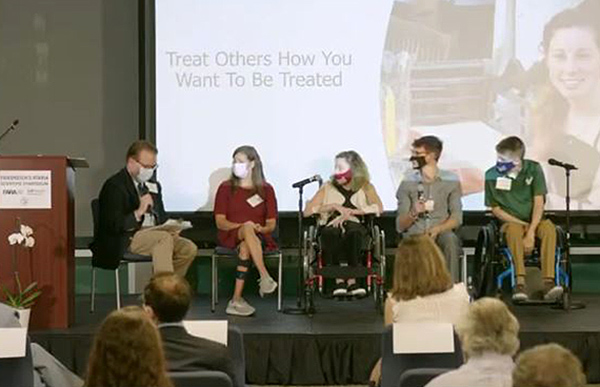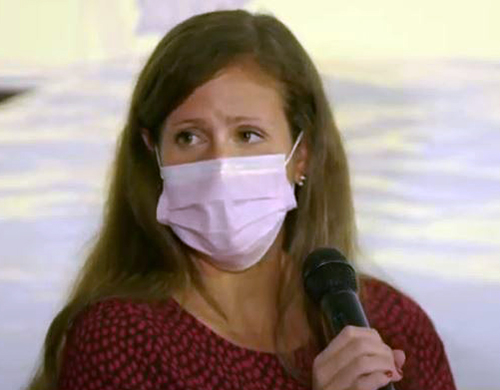This year’s Friedrich’s Ataxia (FA) Scientific Symposium featured some tremendous advances being made toward treatments focused on different targets and stages of FA – a rare, debilitating and life-shortening neuromuscular disorder.
The determination to find a first FA treatment and ultimately a cure “continued because of the dedication of patients and their families, who kept traveling to clinical trials” despite the challenges of the COVID-19 pandemic, Dr. Clifton Gooch, professor and chair of the USF Health Department of Neurology said. “And, researchers, clinical centers and everyone on the FA team said we are not going shut down our clinical trials, because it’s how we beat this disease.”
Speakers addressed more than 700 researchers, clinicians, industry partners, patients and caregivers gathered for the Sept. 25 symposium hosted by the Friedreich’s Ataxia Research Alliance (FARA) and USF Health Ataxia Research Center. Some attended the symposium at the USF Center for Advanced Medical Simulation and Learning (CAMLS), while others joined the livestreamed program on FARA’s YouTube channel.
Friedreich’s ataxia, the most common inherited ataxia, is caused by a mutation (defect) in the frataxin gene, which reduces production of the protein frataxin. The deficiency of this essential protein leads to impaired function of the mitochondria (cell structures that generate energy needed to keep cells working properly), suppression of the transcription factor Nrf2, neuroinflammation, and neurodegeneration. FA is typically diagnosed in children and adolescents and affects multiple organs. Symptoms can include loss of arm and leg coordination, fatigue, vision and hearing loss, slurred speech, curvature of the spine, diabetes, and serious heart conditions including thickening of the heart (cardiomyopathy) and arrhythmias.

Charles Lockwood, MD, senior vice president for USF Health and dean of the Morsani College of Medicine, greeted more than 700 researchers, clinicians, industry partners, patients, and caregivers joining the 2021 FA Scientific Symposium in person and online.
“I could not be more pleased with the strong relationship between FARA and the USF Health Ataxia Research Center,” Charles Lockwood, MD, senior vice president of USF Health and dean of the Morsani College of Medicine, said in his welcome remarks to symposium attendees. “Since 2008, this symposium has become a beacon of hope broadcast around the world.”
The USF Health Ataxia Research Center is one of 13 sites in the Friedreich’s Ataxia Collaborative Clinical Research Network. One of the world’s most active FA clinical research centers, it provides advanced multidisciplinary care (including neurology, physical therapy, exercise physiology, and cardiology) as well as outreach services and patient and family support.
“Many different body parts are affected by Friedreich’s ataxia and they all come together like pieces of a puzzle to produce a profoundly disabling disease,” said Theresa Zesiewicz, MD, professor of neurology and director of the USF Health Ataxia Research Center. “You need a comprehensive team approach to treat patients with this neurodegenerative disease.”

Theresa Zesiewicz, MD, professor of neurology and director of the USF Health Ataxia Research Center, gave an update on the center’s clinical trials.
Dr. Zesiewicz presented an update on USF Health’s participation in several pivotal clinical trials for FA. These include:
- MOVE-FA study (phase 2/3) testing vatiquinone, a potent catalytic antioxidant.
- MOXIe phase 2 study of an Nrf2 activator (omaveloxolone), which induces molecular pathways to improve mitochondrial function and help resolve chronic inflammation.
- Phase 3 study of RT001, a compound that replaces natural fats, known as polyunsaturated fats, to help stabilize cell membranes and protect cells from further oxidative damage.
- Clinical Outcomes Measures in Friedreich’s Ataxia, a natural history study collecting information to better understand FA, quantify its progression over time, and provide insight into how to treat the disease.
Future center studies may include gene therapy, and research on a small-chain protein called “TAT peptide” designed to deliver functional frataxin to mitochondria.
In panel discussions, industry leaders and researchers spoke about their promising disease-modifying and genetic approaches to FA treatment — all moving from preclinical research to various stages of clinical trials.

Members of the Emerging Therapies Panel shared how their companies are applying cutting-edge technologies to slow or stop the progression of Friedreich’s ataxia, the most common inherited ataxia. Barbara Tate, PhD, FARA’s chief scientific officer, moderated.
Late last year, PTC Therapeutics launched a phase 3 trial at several sites across the U.S. (including USF Health), Canada, Europe, Australia and Latin America to further assess its investigational oral therapy vatiquinone in children and young adults with FA, said Matthew Klein, MD, chief development officer for the biopharmaceutical company. Vatiquinone works by blocking the activity of a key enzyme (15-lipoxygenase) regulating the oxidative stress and neuroinflammation underlying many neurological diseases, including FA.
“We found that in FA cells and model systems, the drug was able to turn off excess inflammation, too much cell stress, and return the cell to back to behaving normally. That’s very important for all the parts of the body affected by FA,” Dr. Klein said.
In the preclinical stage, PTC Therapeutics is also testing an adeno-associated virus containing the gene that encodes for the protein frataxin – with the aim of restoring frataxin levels in the central nervous system of FA patients.
Joao Siffert, MD, president and CEO of Design Therapeutics, spoke about the biotechnology company’s pioneering work developing a new class of intravenously delivered small molecules that target the underlying cause of inherited nucleotide expansion diseases. In most individuals with Friedreich’s ataxia, the frataxin gene contains a specific type of error called an expanded GAA trinucleotide repeat.
“What our small molecules are capable of doing – shown in animal models and, more importantly, in cells from patients with Friedreich’s ataxia – is to restore expression of the frataxin gene (by turning on transcription from DNA to RNA) and, ultimately, restore production of normal levels of the frataxin proteins,” said Dr. Siffert, adding that Design Therapeutics plans to launch an FA early-stage clinical trial by summer 2022.

Members of the Clinical Stage Panel discussed clinical trials, in various stages of development, testing FA disease-modifying and genetic therapies. Jen Farmer, CEO of FARA, moderated.
Mark Mannebach, PhD, vice president of regulatory affairs for Exicure Therapeutics, discussed the biotechnology company’s approach to delivering gene therapy using spherical nucleic acid (SNA™) technology. SNAs consist of nucleic acid sequences attached to a spherical nanoparticle. They can enter nearly all cell types, including those in the brain and nervous system, to alter gene expression without the harmful side effects sometimes associated with conventional forms of gene therapy.
“In extensive preclinical studies, we’ve observed increases of frataxin protein to near-normal levels in fibroblasts and neurons derived from FA patients,” Dr. Mannebach said.
Other industry speakers included Nancy Ruiz, MD, chief medical officer of Larimar Therapeutics, and J. Warren Huff, MD, president and CEO of Reata Pharmaceuticals.
FARA CEO Jen Farmer noted that all the investigational therapies highlighted at this year’s symposium have slightly different targets.
“So, our hope is that they will all work together to get us to our goal of treating and curing Friedreich’s ataxia,” said Farmer, who moderated the clinical trials panel. “We need multiple therapies to treat all the organ systems affected by FA and to attack the disease at different stages.”
In a panel discussion moderated by Dr. Gooch, patients shared their perspectives on living with FA and why they persevere as clinical trial participants. The panelists were Bridget Downing, 35, a teacher from Charleston, SC, diagnosed with FA at age 10; Gavin Lambert, 16, a New Port Richey high school student diagnosed at age 5 and recipient of the Freddie Solomon Moral Courage Award for his successful completion of the Tampa Bay Kids Triathlon. Christian Maugee, 22, a PhD candidate in the ALS-frontotemporal dementia program at the University of Florida, Gainesville; and Isabel Maugee, 22, who works at her family’s business in Fort Lauderdale. Twins Isabel and Christian were both diagnosed at age 9.

Patients shared their perspectives on living with Friedreich’s ataxia and the importance of participating in clinical research to move one step closer to a treatment and, ultimately, a cure.

Bridget Downing, 35, a classroom teacher from Charleston, SC, who was diagnosed at age 10, maintains her mobility with the help of a Segway.
“Even if a trial does not reach the endpoint we want, I know the data collected goes toward advancing the greater scientific knowledge,” said Downing, who gets around on a Segway and recently completed a half-marathon using a hand cycle. “I’ve learned over the years not to let FA define me and to appreciate the people in my life who do not treat me differently… I don’t let my limitations stop me; I just keep moving forward even when things change.”
In closing remarks, Dr. Gooch emphasized that there were more ongoing FA clinical trials and preclinical studies in the pipeline than ever before.
“Those investigational therapies to modify the disease process — especially when administered in combination like the cocktail therapies we use with cancer patients — may get us to the point where we can stop FA or perhaps even reverse it,” Dr. Gooch said. “And increasingly we have new gene therapy technologies coming along, some approaching clinical trials now, that will be employed to fix the problem at its source.”

Clifton Gooch, MD, professor and chair of the USF Health Department of Neurology, moderated the FA Patient Panel and delivered closing remarks.
He encouraged all in FA community to continue working together and remain hopeful. “We will win this fight with your help. We will make Friedreich’s ataxia a footnote in history.”
The symposium’s momentum continued Sept. 25 with the 2021 FARA Energy Ball, which benefits FARA and USF Health. This year’s event generated $1.6 million to help fund drug discovery and development and clinical research.


